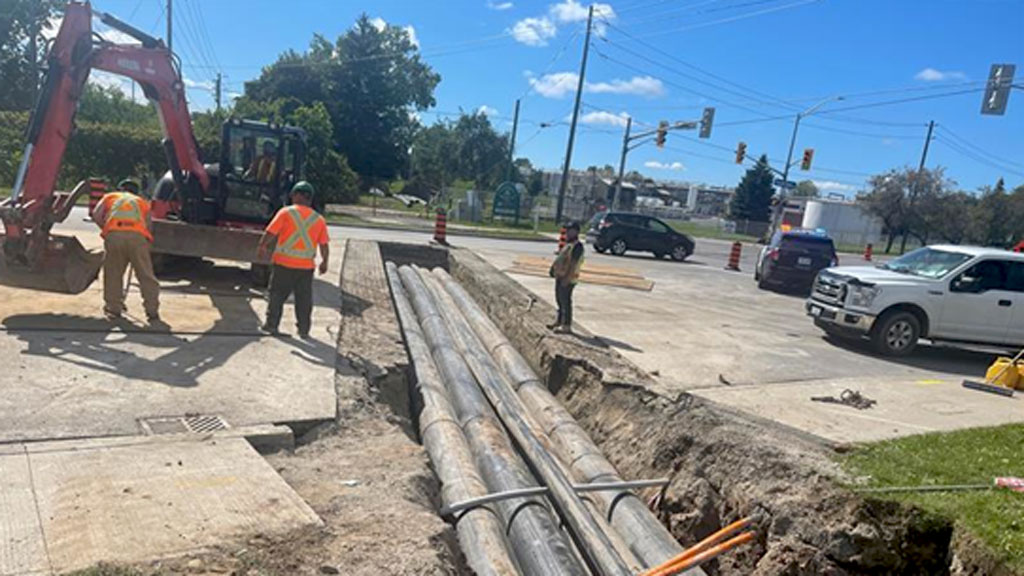Named the 2022 North American Society of Trenchless Technology No-Dig North Project of the Year, the second phase of the complex sewer rehabilitation in Niagara Falls, Ont. was carried out with almost meticulous precision.
That’s not to suggest the first phase wasn’t.
But the now-wrapping up Stamford Interceptor Trunk Sewer Rehabilitation — Phase II was even more challenging than the first because of the need to manage large sewage flows from two separate trunk systems while a cured-in-place pipe (CIPP) lining was installed.
“There are even more flows in that area,” says Niagara Region project manager Derek Falardeau-Mercier, referring to where an east-west trunk connects with the south-to-north Stamford Interceptor.
And that was just one of the numerous challenges, which also included the need to build temporary access roads, the hurdles posed by uneven terrain along an Ontario Power Generation corridor, and the necessity to erect fencing to protect construction workers from an adjacent hydro canal that delivers water to the Sir Adam Beck Generating Station.
Signs and public consultation were also required because the second phase also forced the temporary closure of a hiking trail. As well, there was some traffic disruption because a bypass piping system had to be trenched across Thorold Stone Road.
“The Stamford Interceptor Trunk Sewer is the largest sewer pipe the region has rehabilitated so far,” says Falardeau-Mercier, explaining careful planning and co-ordination between the region, OPG and the City of Niagara Falls mitigated the impacts to the community.
Divided into two phases due to the size, cost and complexity, the project involved the installation of the CIPP lining into almost 2,500 metres of the Stamford trunk sewer which directs sewage to the the Niagara Falls Wastewater Treatment Plant.
Phase 1, which was the first 2,300 metres, was designed in 2016-17 and constructed in 2019-2020. The second 1,560-metre-long rehabilitation was designed in 2019-2020, with construction starting in July 2021 and substantial completion anticipated in December 2022.
However, some restoration is still ongoing.
LiquiForce Services (Ont.) was the general contractor for both phases and Insituform was its lining subcontractor. The consultant was Robinson Consultants.
The catalyst for the project was a 2015 assessment of the trunk sewer, using closed circuit television, which revealed several segments were in very poor condition through corrosion.
Four different trunk sewers were actually assessed that year and then prioritized based on their overall condition and failure risk.
Constructed in the early 1960s, the concrete sewer had become so badly deteriorated the steel reinforcing system had become exposed, says Falardeau-Mercier.
Trenchless rehabilitation methods and open-cut construction were all evaluated by the region, taking into consideration the potential overall costs, risk, constructability, public disruption and other factors such as scheduling.
Ultimately, it chose trenchless rehabilitation using a CIPP method as it provided the greatest benefit and the most environmentally sustainable, he says.
“It avoided the use of large trenches and excavations which typically produce a substantial amount of debris hauled to landfills, minimized traffic and resident disruption, and reduced remediation works afterwards.”
Widely used in many Ontario municipalities, CIPP is a trenchless pipe repair method that involves inserting and curing a resin impregnated tube within existing deteriorated pipes, says Falardeau-Mercier.
“The goal of this process is to rehabilitate the existing pipeline by providing structural support and corrosion protection from the hydrogen sulfide from the sewage within the newly hardened pipe.”
Still, there are challenges with this system. An above ground bypass system had to be set up to reroute the sewage flow around the area as the CIPP process requires a dry pipe for the installation of the liner and a wastewater treatment plant can’t be shut down. In the case of Phase II, six pumps and four bypass pumps were used.
“Setting up the bypass system is quite labour intensive,” he points out.
After the sewer was cleaned the resin impregnated liner tube was then inverted into the sewer, in sections from maintenance hole to maintenance hole, using air which inflated the liner tight up against the original pipe.
Heat through steam was then introduced inside the pipe to initiate the curing chemical reaction in the resin. As a result of this process, the liner hardened and was transformed into a fully structural pipe.
“It’s basically a pipe-within-a pipe.”
However, that was not the end of the project or the work as there had to be a designated cool down period.
“The hot steam and the heat created by the chemical reaction in the resin during the curing period is extremely high. There is a risk the liner can crack if it is cooled down too quickly, so the cool down process is equally important as the curing process.”
During the two weeks that the lining process was being undertaken the contractor was onsite 24/7 to monitor the bypass system and complete the lining work.
Two crews were used, a day crew for the liner installation and night crew which handled the cool down, trimming the liner at the maintenance holes and setting up equipment for the following day.
An especially critical task was the removal, through a filtering system, of the condensation which includes traces of styrene from the resin. An organic compound, styrene could have negatively impacted the wastewater treatment plant’s biological system, says Falardeau-Mercier.






Recent Comments
comments for this post are closed